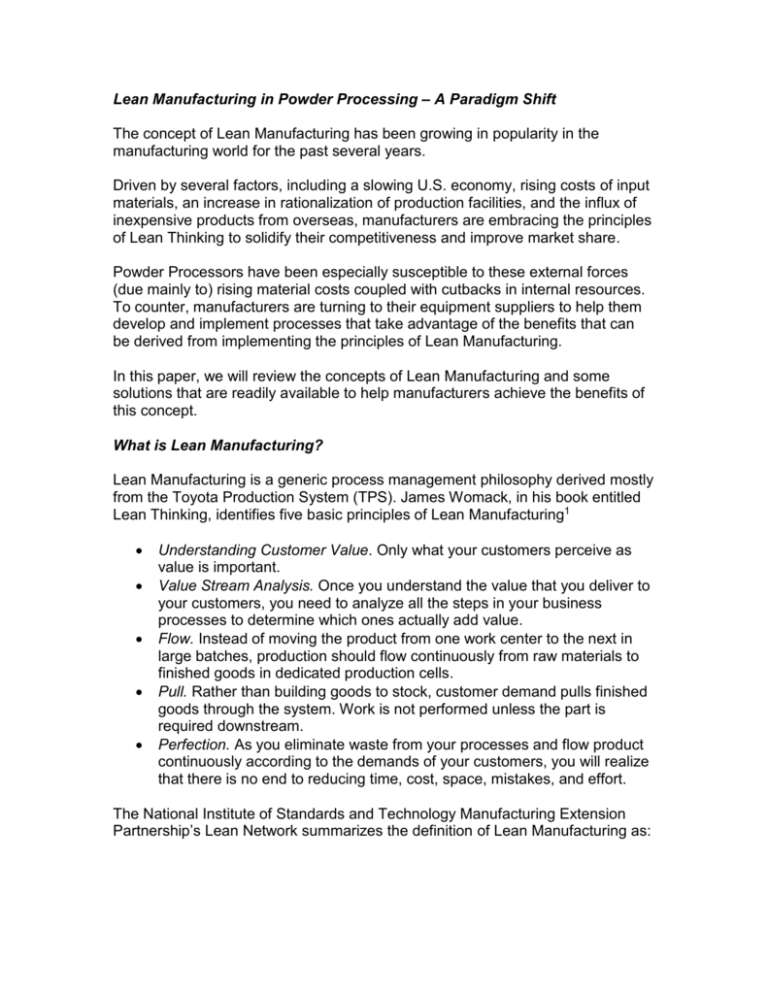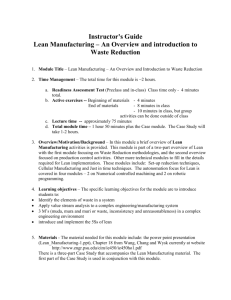lean-manufacturing - Processing Magazine
advertisement

Lean Manufacturing in Powder Processing – A Paradigm Shift The concept of Lean Manufacturing has been growing in popularity in the manufacturing world for the past several years. Driven by several factors, including a slowing U.S. economy, rising costs of input materials, an increase in rationalization of production facilities, and the influx of inexpensive products from overseas, manufacturers are embracing the principles of Lean Thinking to solidify their competitiveness and improve market share. Powder Processors have been especially susceptible to these external forces (due mainly to) rising material costs coupled with cutbacks in internal resources. To counter, manufacturers are turning to their equipment suppliers to help them develop and implement processes that take advantage of the benefits that can be derived from implementing the principles of Lean Manufacturing. In this paper, we will review the concepts of Lean Manufacturing and some solutions that are readily available to help manufacturers achieve the benefits of this concept. What is Lean Manufacturing? Lean Manufacturing is a generic process management philosophy derived mostly from the Toyota Production System (TPS). James Womack, in his book entitled Lean Thinking, identifies five basic principles of Lean Manufacturing1 Understanding Customer Value. Only what your customers perceive as value is important. Value Stream Analysis. Once you understand the value that you deliver to your customers, you need to analyze all the steps in your business processes to determine which ones actually add value. Flow. Instead of moving the product from one work center to the next in large batches, production should flow continuously from raw materials to finished goods in dedicated production cells. Pull. Rather than building goods to stock, customer demand pulls finished goods through the system. Work is not performed unless the part is required downstream. Perfection. As you eliminate waste from your processes and flow product continuously according to the demands of your customers, you will realize that there is no end to reducing time, cost, space, mistakes, and effort. The National Institute of Standards and Technology Manufacturing Extension Partnership’s Lean Network summarizes the definition of Lean Manufacturing as: “A systematic approach to identifying and eliminating waste through continuous improvement, flowing the product at the pull of the customer in pursuit of perfection.”2 Lean Manufacturing and Powder Processing Jerry Kilpatrick in his paper on Lean Principles2 identifies a number of common tools or Lean Building Blocks that are available to manufacturers. While any of these may be implemented as stand-alone programs, the true impact on the bottom line will only come when several are implemented in the proper sequence. These “building blocks” include: Pull System – producing product at customer demand. Kanban – method for maintaining an orderly flow of material. Work Cells – arranging operations and/or people in a cell vs a line. Total Productive Maintenance – co-operative maintenance methodology to optimize machine performance. Total Quality Management – continuously improving all areas of a company's operation. Point-Of-Use-Storage – cutting down on excess movement of people and materials. Quick Changeover - reducing the amount of time to change a process from running one specific type of product to another. Batch Size Reduction – reduced batch sizes shortens the overall production cycle which enables companies to deliver more quickly and to invoice sooner. 5S or Workplace Organization – systematic method for organizing and standardizing the workplace. Visual Controls – simple signals that provide an immediate and readily apparent understanding of a condition or situation. Concurrent Engineering – using cross-functional teams to develop and bring new products to market. Powder Processing Equipment manufacturers can add value in several of these “building block” areas. Integrated Systems One method to add value in a Lean production environment is through the development of integrated systems. An integrated system draws raw material from storage, processes the material to meet the needs of the next processing stage and then delivers that material to that downstream process. An example of this can be seen in this pharmaceutical suite in Figure 1. Figure 1: Pharmaceutical Figure 1 Suite In this example, pre-screened raw materials are pneumatically drawn from the source, delivered to an in-line mill which conditions powders prior to entry into the high shear mixer. This ensures no powder lumps occur due to agglomerates. In the second step, the material is pneumatically conveyed from the high shear mixer through a mill, into a fluid bed dryer. This process ensures that all material entering the Fluid Bed Dryer is small and uniform in size. The result is decreased drying times, quicker batch turns, lower energy usage and decreased material waste. In the last step, the material is drawn through a mill to final size reduce the product for further processing or packaging. Integrated systems provide several benefits that are in line with the building blocks of Lean Manufacturing. First off, by pneumatically conveying the product, the raw material can be taken from the point-of-use-storage and efficiently moved through the processing stream to the next step or final packaging. This “pull system” reduces the labor required to physically move the material and decreases the risk of workplace injury. Secondly, this system reduces material waste. By eliminating foreign contaminants at the start of the process, waste from excess energy usage, rework and spoiled material is reduced and/or eliminated. And finally, the number of batch turns are increased. If the material enters each stage properly sized and contaminant-free, process batch times are reduced. Couple this with quick change capabilities (easy-to-clean, sanitary equipment designs), the number of batches produced in a single operating day are increased, with the added advantage of being able to change the product line over completely if the needs of the customers should change. Portable Processing Systems Figure 2 Portable Quadro® Fine Grind System Portable, integrated complete processing systems provide the ultimate in Lean Manufacturing benefits. Combining a complete, controlled, recipe driven processing environment with the ability to be in close proximity to the next processing step, helps decrease overall plant maintenance costs and preserve floor space. Inline Technologies Figure 3 Quadro® Comil® Inline Mill Inline technologies provide another means for process equipment to help achieve Lean Manufacturing benefits for the manufacturer. Inline processing equipment is designed to be flexible. They can be configured to meet optimal process layout in a minimal processing space, to minimize product transportation and decrease labor. They are also designed to run continuously. To achieve this, most inline systems employ a minimal number of parts in the process area. This reduces downtime for equipment servicing and cleaning which helps a manufacturer complete more batches in a given operating day. Figure 4 Quadro Inline Sifter Visual Controls Another area where equipment suppliers can help manufacturers achieve the benefits of Lean Manufacturing is through the incorporation of Visual Controls in the process stream. By using smart controls such as recipe driven, user interface panels coupled with sensors throughout the process and warning sounds/lights, operators can immediately know when the process is out of specification. These smart panels can also capture key operating statistics which can be downloaded to a PC or PDA for easy reference. Total Productive Maintenance Equipment manufacturers can also help in the implementation of Total Productive Maintenance. By working with operators and maintenance personnel, equipment manufacturers can help calculate wear rates and set-up required replacements times for various critical components. This will help decrease operating costs, improve equipment life, and lower overall maintenance costs and avoid downtime due to unexpected equipment failure. In summary, Lean Manufacturing can provide real, tangible benefits to manufacturers. Integrated systems, portable processing systems, inline technologies, visual controls and total productive maintenance are all tools that can be employed to achieve these benefits. Equipment suppliers can help manufacturers develop and implement these processes. This will help manufacturers compete in today’s increasingly uncompromising global market and excel in these challenging times. 1 Womack, James P. and Daniel T. Jones, Lean Thinking, Simon and Schuster, New York, NY, 1996 2 Jerry Kilpatrick, Lean Principles, Utah Manufacturing Extension Partnership, 2003








